Montana has well over a dozen birds that stay during the winter, and several others that migrate to the state. Winters in Montana are cold and snowy. The coldest month in the state is January, when lows drop to 15°F. However, the coldest temperature ever recorded in the state was an appalling -70°F. Even with these chilling conditions, birds stay! Follow along to discover the 15 birds that spend their winters in Montana.
Red-breasted Nuthatches

People often mistake nuthatches for woodpeckers because of their long, pointed beaks and their foraging behavior.
©iStock.com/M. Leonard Photography
Starting our list of the 15 birds that spend their winters in Montana is the red-breasted nuthatch. This beautiful and small nuthatch is listed as Least Concern on the IUCN Red List. In Montana, you can find these adorable birds in coniferous forests. They have short tails and almost no necks. Red-breasted nuthatches vary a little in appearance depending on the sex. Males are more vibrant with a black crown, while female red-breasted nuthatches have gray crowns.
Generally, these birds are about 4.3 inches long and weigh as little as 0.3 ounces. Their wingspans are a little under 8 inches long. Red-breasted nuthatches are fast fliers and spend a lot of time on trees. When climbing down, they start headfirst.
Rough-legged Hawks
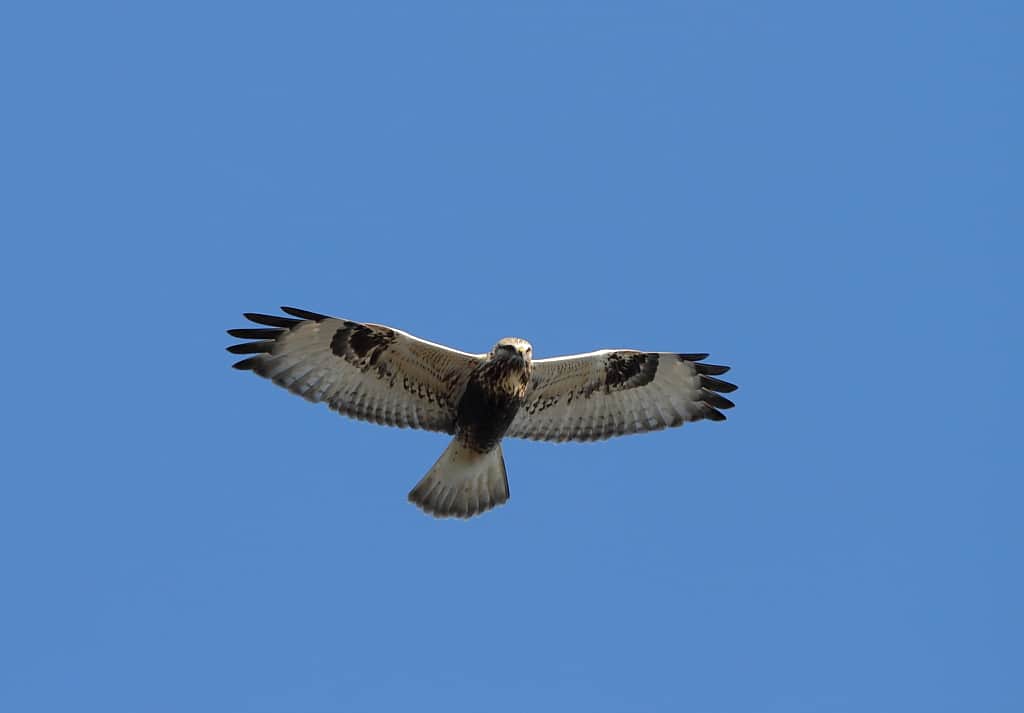
The rough-legged hawk (Buteo lagopus), also known as the rough-legged buzzard, lives on three continents across 50 countries.
©1,024 × 713 pixels, file size: 355 KB, MIME type: image/jpeg – License
Another incredible bird that lives in Montana during winter is the rough-legged hawk. These birds are fairly large with a wingspan of up to 54.3 inches. Rough-legged hawks are also 18 to 20.5 inches long and may weigh as much as 50 ounces. They are slightly smaller than a red-tailed hawk.
Although these large hawks nest in Alaska and Canada, during the cold winters, they fly through the continental United States, including Montana. In Montana, you can see these large birds from October through March, or sometimes as late as April.
American Tree Sparrow
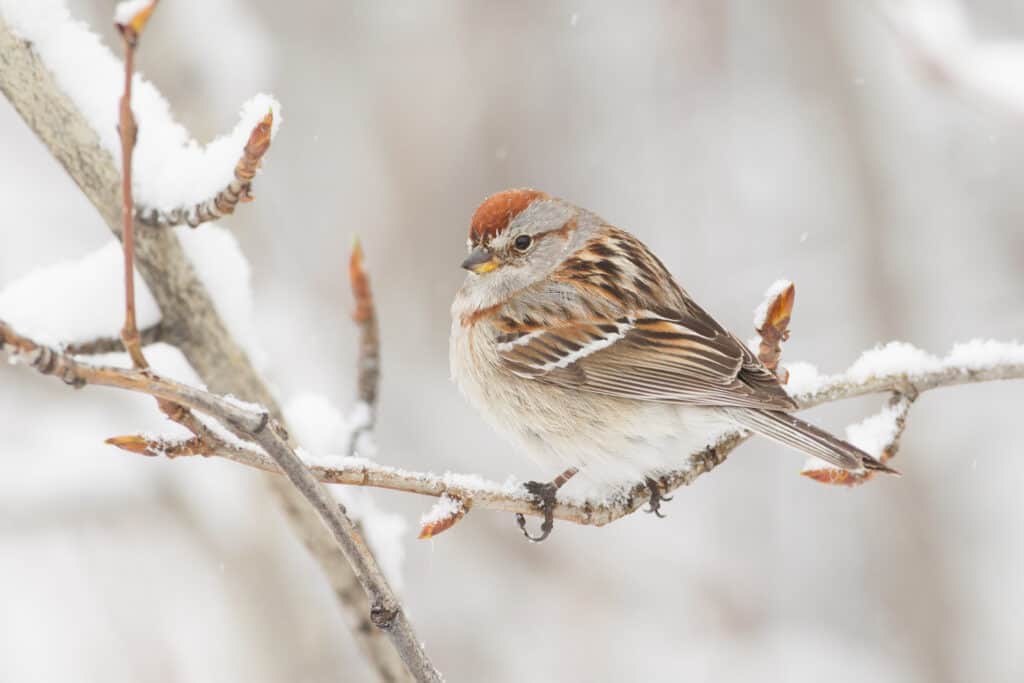
American tree sparrows are also called winter sparrows.
©Jukka Jantunen/Shutterstock.com
Also in Montana is the American tree sparrow. Another name for this sparrow species is the winter sparrow. They are native and widespread throughout the state. American tree sparrows are relatively small weighing as little as half an ounce. They are puffy and short birds with a rusty cap and a grey face. You can also identify them from the small dark spot on the breast. Like the previous birds, they nest in Alaska and northern Canada but migrate to the United States and southern Canada during winter. During winter, you may see them flock together to eat on the ground or at bird feeders. They mainly eat seeds and insects with the occasional berry.
Mourning Dove

Mourning doves are monogamous.
©Tom Cantaffa/Shutterstock.com
Continuing our list of birds that spend their winters in Montana is the mourning dove. Mourning doves are native to Montana and have a wide range in the United States. They are beautiful medium to large-sized birds with small heads and pointed tails. They are slender and have light gray-brown plumage with hints of very light pink. Their wings also have black spotting, while their outer tail feathers are white. This contrast is stunning. Mourning doves range in size but are usually about 12 inches long. They can weigh up to 6 ounces. These loud birds are also very vocal and almost sound like owls. Males coo loudly to attract females. Mourning doves are monogamous, some partners even stay together for life.
Cedar Waxwing
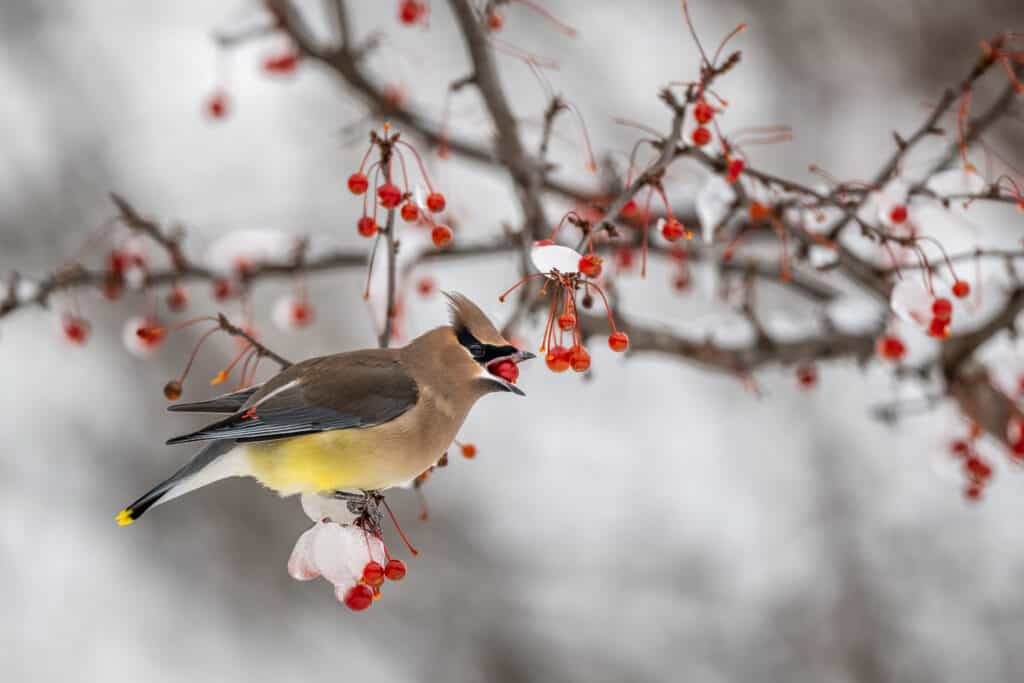
Cedar waxwings feed on various berries like wild cherries and juniper and consume insects like beetles, ants, and caterpillars.
©Skyler Ewing/Shutterstock.com
Next is the cedar waxwing, which is a medium-sized passerine bird weighing about 1.1 ounces. Although you can find these birds in Montana during winter, they are more common in summer. Most cedar waxwings migrate to warmer climates during winter, while some stay. Those who leave though leave Montana by mid-October and return in May.
Cedar waxwings are brown, gray, and yellow birds with little mohawks. They differ in size and appearance though depending on gender and age. Cedar waxwings are called waxwings because of the small clusters of red wax-like droplets on the tips of secondary flight feathers on the wings. They also have bold black masks with a light white border.
House Wren
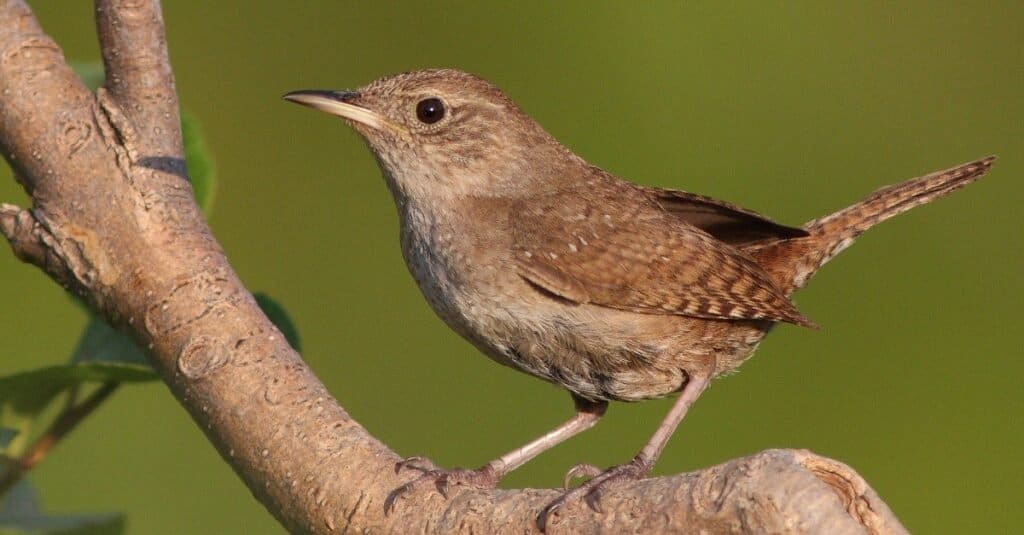
House wrens are very small songbirds that weigh less than 0.5 ounces.
©iStock.com/mirceax
Also in Montana are house wrens, very loud and small songbirds with a wide distribution in the United States. These stocky brown birds are frequent visitors to parks and backyards, although they don’t always feed from bird feeders.
House wrens are found from Canada to southernmost South America. They only weigh about 0.35 ounces and have a wingspan of less than 6 inches. These small and vocal birds have a cheery and bubbly song. However, their songs differ depending on the region.
Northern Flicker

Another beautiful winter bird in Montana is the northern flicker. It’s one of the largest
woodpecker
species in the state.
©abriggs21/iStock via Getty Images
Northern flickers are gorgeous birds. They are sometimes confused with mourning doves because of their similar eyes but have more markings. Northern flickers are the second largest woodpecker in northwestern Montana. They are common throughout the state.
These large, brown woodpeckers also live in parts of Central America, Cuba, and the Cayman Islands. They are excellent fliers and migrate, which is a rare trait for woodpeckers. Northern flickers are divided into two subspecies groups, where there are about 10 recognized subspecies.
Northern flickers spend a lot of time in trees. They nest in holes in trees and look for food both on trees and on the ground. Northern flickers mainly eat insects, specifically ants.
Rock Pigeon

Rock pigeons are common birds in Montana.
©Opasbbb/Shutterstock.com
Continuing our list of the 15 birds that spend their winters in Montana is the rock pigeon. They are very common in the state, especially in urban areas like large cities and parks. Rock pigeons are members of the Columbidae family. They live for about 6 years and are 20 to 26 inches long. Rock pigeons can also weigh between 8.4 and 13 ounces.
Red-winged Blackbird
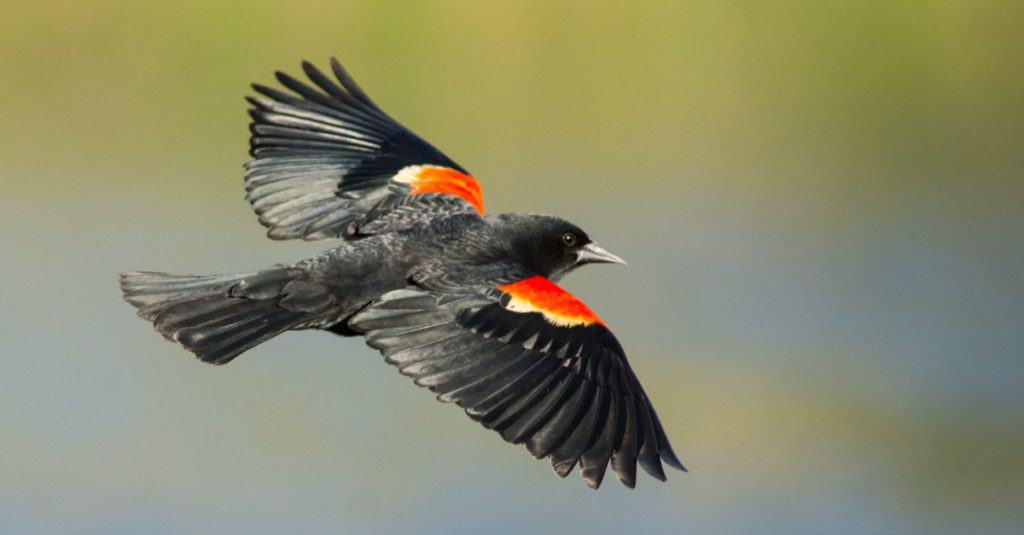
Male red-winged blackbirds are nearly all-black with red-shoulder spots on their wings. On their red spots, they also have a splash of yellow. Female red-winged blackbirds look nothing like the males.
©JoshCW Photo/Shutterstock.com
It isn’t extremely common to see a red-winged blackbird in Montana, but a few overwinter in western Montana in mixed flocks. Red-winged blackbirds are gorgeous and striking. They are easy to identify from other birds because of their black, shiny feathers and distinct red patches.
Red-winged blackbirds are passerine birds with a wide range. Females and males look extremely different. Only males have distinct red patches and are all black. Female red-winged blackbirds are brown, grey, and white. Females are also smaller, sometimes weighing as little as one ounce.
Snowy Owl

Snowy owls are large and majestic animals in Montana. Female snowy owls are larger than males and can measure up to 28 inches long.
©Carol Gray/iStock via Getty Images
Did you know you can also see snowy owls in Montana? These snow-white and gorgeous birds though are hard to spot as they camouflage well. Snowy owls are agile and excellent hunters. They go by many names, including the polar owl, the white owl, and the Arctic owl.
Snowy owls are large and majestic. They are about 20 to 28 inches long, although females are larger than males. The average male snowy owl is 23.1 inches long. Females may weigh as much as 6 pounds.
Snow Bunting
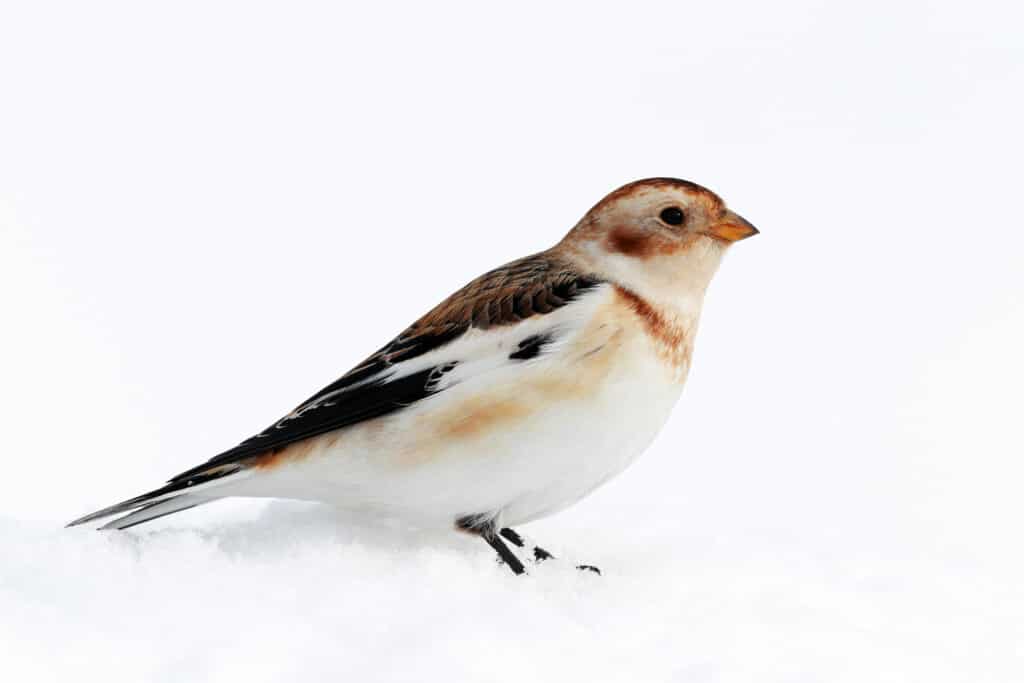
Like other species, the male can be more brightly colored than the female.
©Mark Medcalf/Shutterstock.com
Snow buntings are another stunning winter bird in Montana. They are medium-sized passerine birds that vary depending on age and sex. Female snow buntings have black wingtips and a rufous back. Breeding male snow buntings, on the other hand, are white with black wingtips and a black back.
These gorgeous birds have a distinct song/call that sounds like a high whistle. They live in very high latitudes in the Arctic tundra but migrate to many warm countries during winter including Germany, the United States, Ukraine, and Canada. Snow buntings eat a lot of different things. The exact diet of this bird though depends on the season. During winter, they eat seeds from lower stems. In summer though, they eat seeds, poppies, butterflies, and spiders.
Western Meadowlark
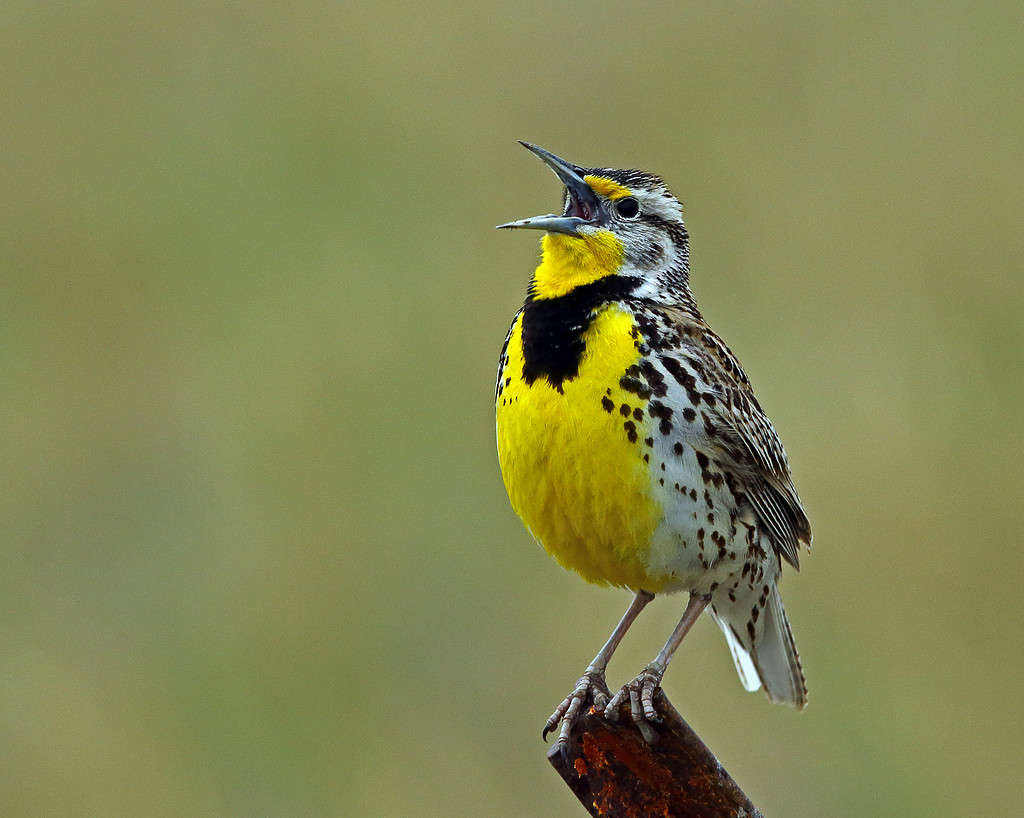
Montana’s state bird is the western meadowlark.
©photographybyJHWilliams/iStock via Getty Images
Western meadowlarks are native to Montana. They are loud and gorgeous songbirds with long, slender bills and short tails. Western meadowlarks are about 8.5 inches long. Their wingspans can be nearly double the size of their length. They are iconic birds in the United States. The western meadowlark is the state bird of Kansas, Montana, Nebraska, North Dakota, Oregon, and Wyoming. This bird is very common and is listed as Least Concern on the IUCN Red List.
Western meadowlarks mainly consume insects, although they also feed on fruits like small berries, and seeds. You can find them in grassy plains, meadows, and abandoned fields.
Northern Shrike

Northern shrikes are common in Montana. They have a varied diet but mainly eat insects, small mammals, and birds.
©Martin Pelanek/Shutterstock.com
Another incredible bird that spends their winter in Montana is the northern shrike. These large songbirds are members of the Laniidae family. They are native to North America and Siberia. There are multiple subspecies split into two groups, the East Eurasian Group and the North American group.
Northern shrikes are about 9 inches long and may weigh up to 2.8 ounces. Their wingspans range from 11.8 to 13.8 inches. Northern shrikes are mainly grey, black, and white. They have a bold black mask on their eyes. These lovely songbirds are also excellent hunters. They eat small mammals, insects, and sometimes birds like house finches.
Black-billed Magpie
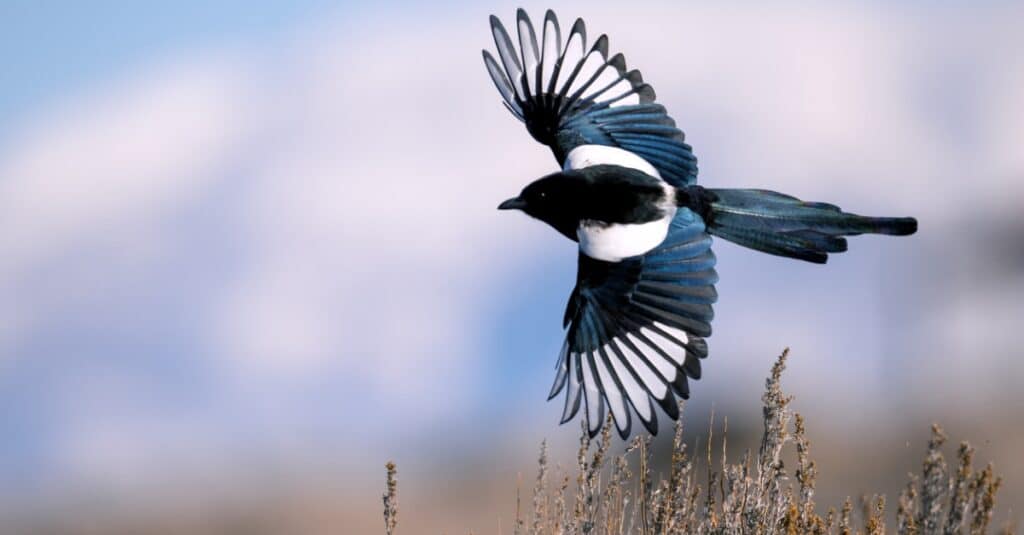
Magpies often form friendships with people.
©iStock.com/kojihirano
Nearing the end of our list is the black-billed magpie. This striking bird is very territorial. They have been observed defending their nests and territory, which includes attacking dogs, cats, other birds, and even humans. These unique birds live in parts of the western half of North America.
They are black and white with small hints of iridescent feathers. Currently, they are listed as Least Concern on the IUCN Red List. Magpies can be considered pests if you live in Montana as they are opportunistic feeders, sometimes tearing through garbage bags for food.
Yellow-rumped Warbler
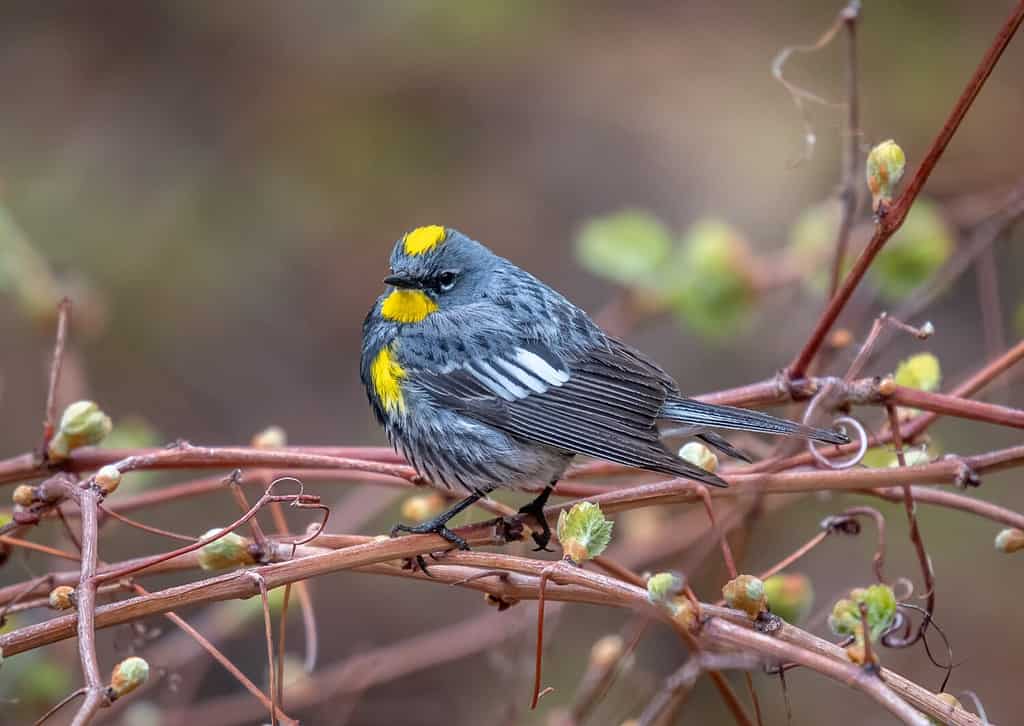
Yellow-rumped warblers have a wide diet. They are excellent foragers that consume insects, seeds, and fruits.
©Gerald A. DeBoer/Shutterstock.com
The last bird on our list of the 15 birds that spend their winters in Montana is the yellow-rumped warbler. This gorgeous bird is about one out of 14 warblers found in Montana. They are excellent foragers and consume many different types of insects like beetles, caterpillars, ants, gnats, and grasshoppers. They are great birds to have in your garden as they can get rid of pests.
Yellow-rumped warblers also consume fruits when insects are scarce. They eat fruit from poison ivy, poison oak, and Virginia creeper. These gorgeous birds frequent bird feeders, preferring sunflower seeds.
The photo featured at the top of this post is © Jay Gao/Shutterstock.com
Thank you for reading! Have some feedback for us? Contact the AZ Animals editorial team.






